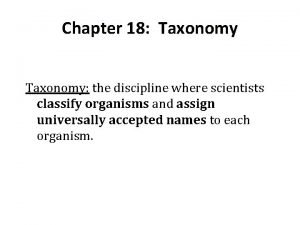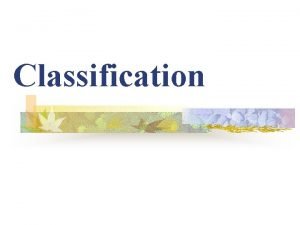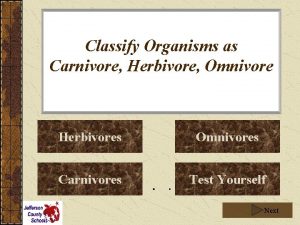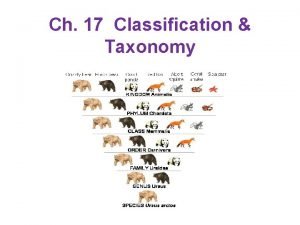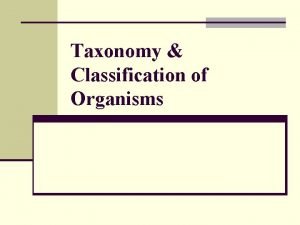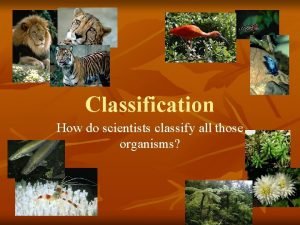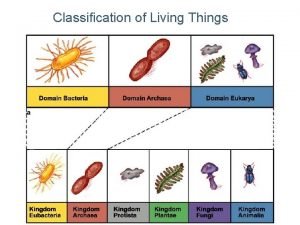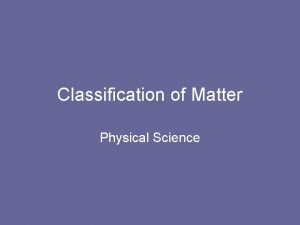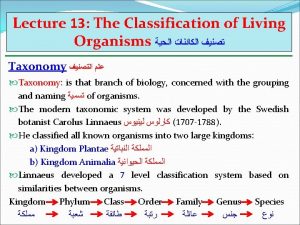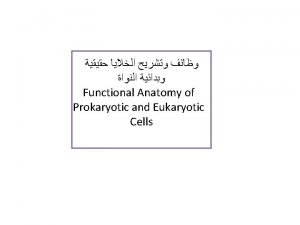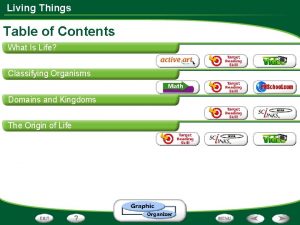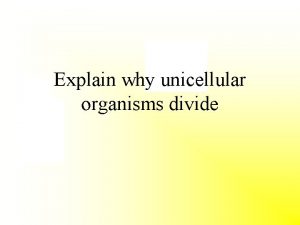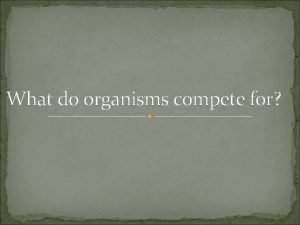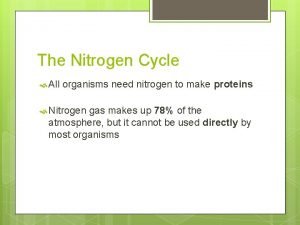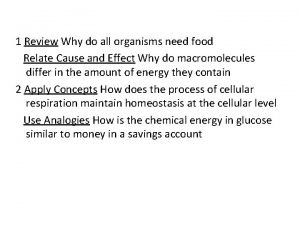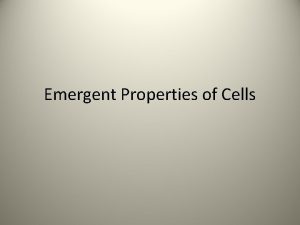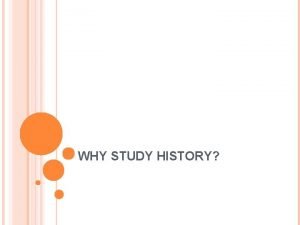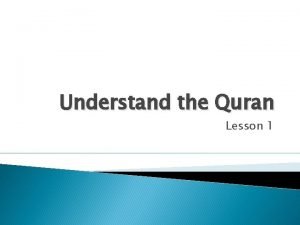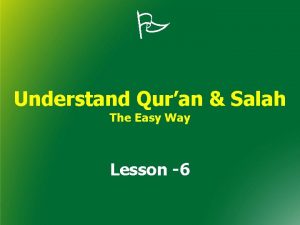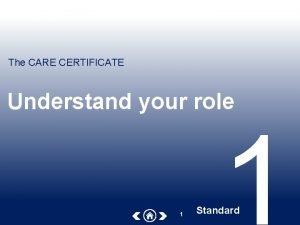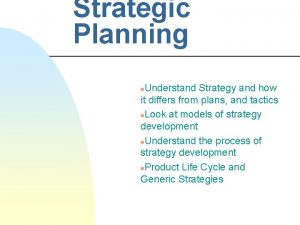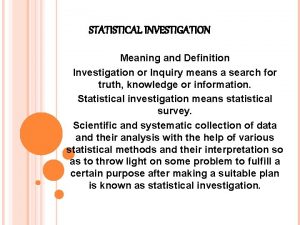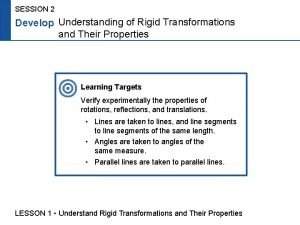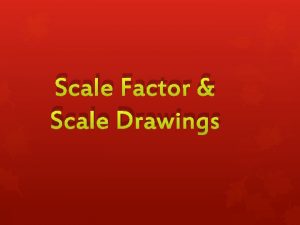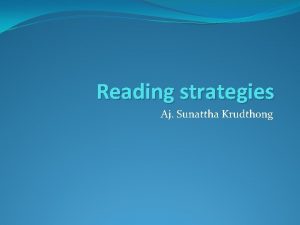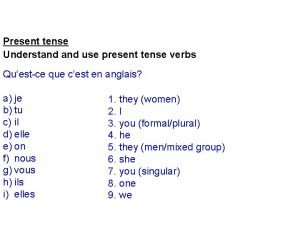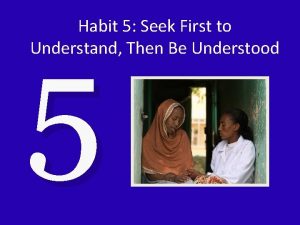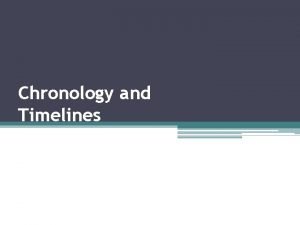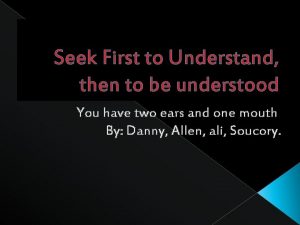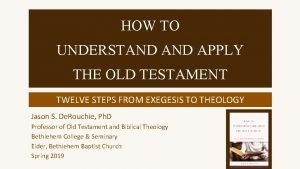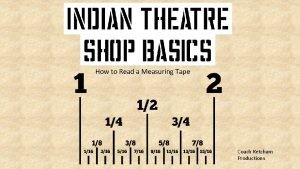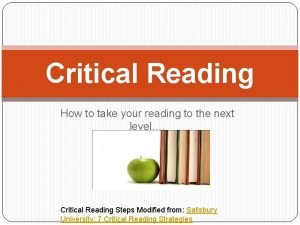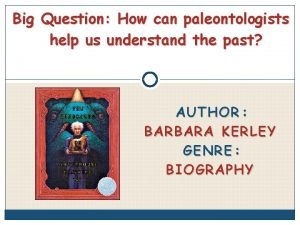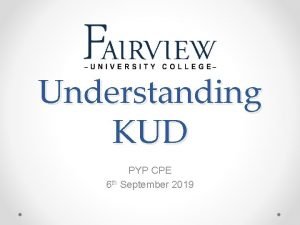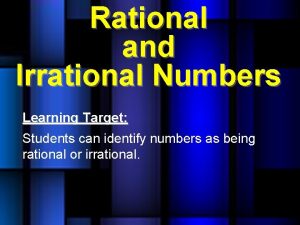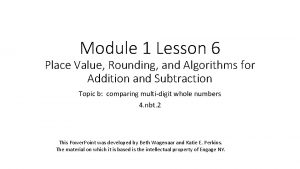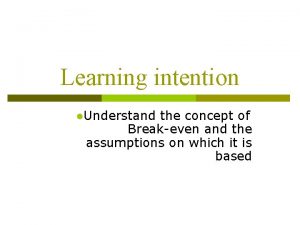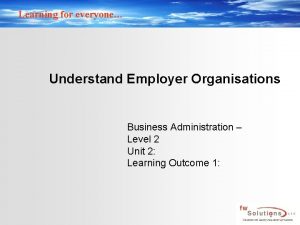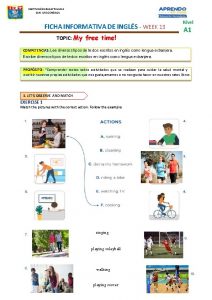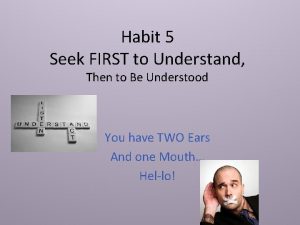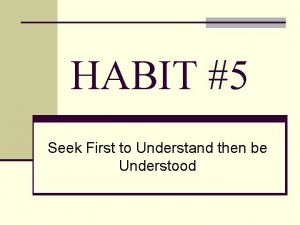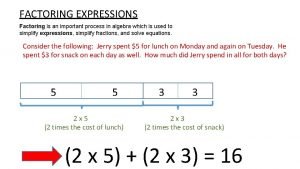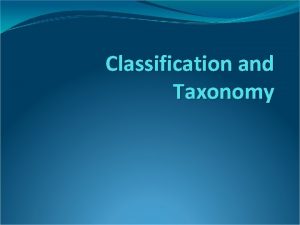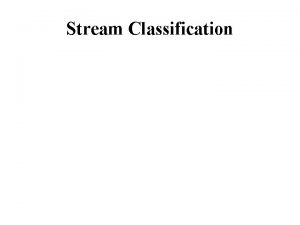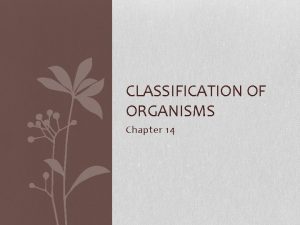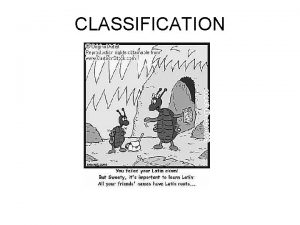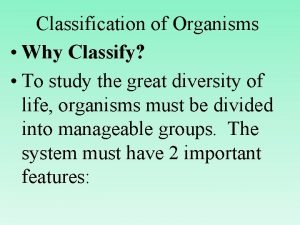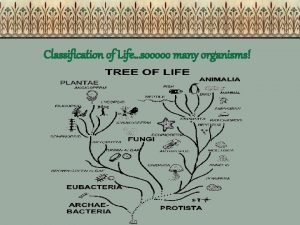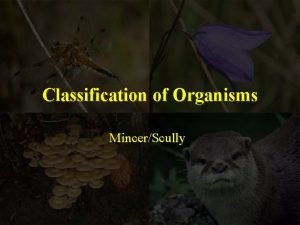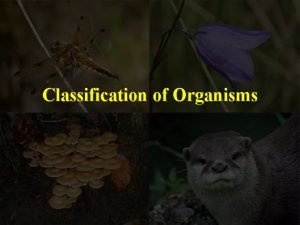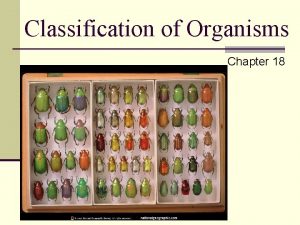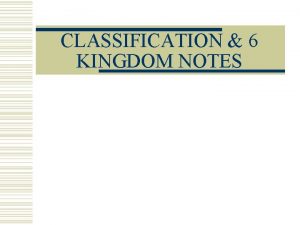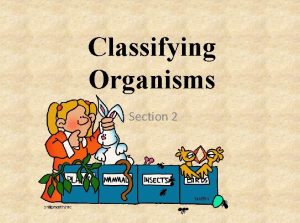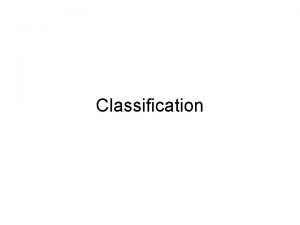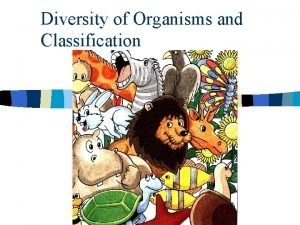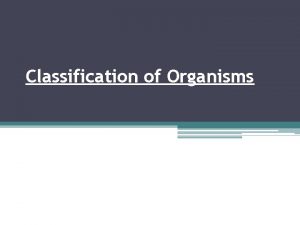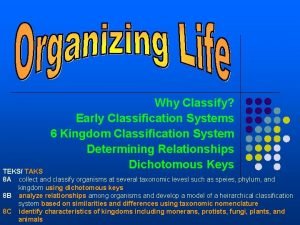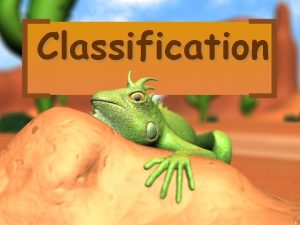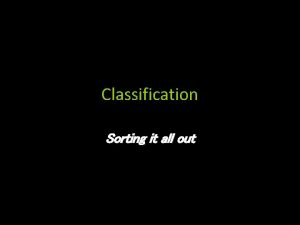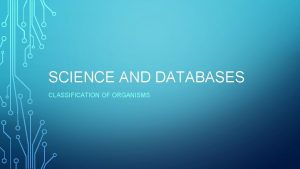Classification Why classify To understand how organisms are































































- Slides: 63

Classification Why classify? To understand how organisms are related and how they are different. • Classification: The logical grouping of organisms based on criteria & characteristics of “biological significance. ” • Taxonomy: Branch of science that classifies organisms & names them using “Binomial Nomenclature. ” • Binomial Nomenclature: Scientifically accepted naming system using two names. – – – Genus species Genus - ALWAYS CAPITALIZED! species- always lower case! Names are Latin – universal language Ex. red oak Scientific Name = Quercus rubra

Taxonomy • Aristotle– An ancient Greek philosopher who developed the first classification system and organized organisms as either plants or animals. • Carolus Linnaeus (1700’s) – developed a classification system based on physical characteristics – only 2 kingdoms. – Originally Linnaeus only used physical characteristics to group & name organisms.

Taxonomy Now Taxonomists also use: • Phylogeny- the evolutionary history of a species. – Taxonomist use cladograms to show the evolutionary relationship between organisms. – A cladogram is a branching diagram that represents the proposed phylogeny or evolutionary history of a species or group. – Derived character – a new trait that was not found in the ancestor

Cladogram Derived character

Taxonomy Now Taxonomists also use: • Genetics - Similarities in an organism’s genes can be used to help determine how organisms are related to each other and how the species have changed over time Cladogram

Taxon – a named group of organisms Become • Domain more • Kingdom specific! • • • Phylum Class Order Family Genus Species

VIRUS Viruses are nonliving particles that can only reproduce within a HOST CELL (living cell). • Can NOT carry out life-sustaining functions.

VIRUS Viral Structure: 1. Nucleic Acid – DNA or RNA encodes for the synthesis of proteins – making new viruses 2. Capsid – protein coat surrounding nucleic acid; arrangement determines shape protects the nucleic acid from digestive enzymes contains special sites on its protein surface that allow the virus to attach and penetrate the host cell membrane 3. Envelope – membrane surrounding capsid; NOT found in all viruses

Virus • Viral Replication – Capsid proteins on virus must match proteins on host cell.

Viral Replication Lytic cycle: 1. virus attaches to host cell and injects viral DNA 2. viral DNA uses host cell to create new viruses 3. new viruses assemble – destroying host Lysogenic cycle: 1. virus attaches to host cell and injects viral DNA 2. viral DNA integrates with host DNA creates provirus 3. provirus is replicated along with host cell’s DNA 4. virus may become active, switching to the lytic cycle, destroying host

TREATMENT • Antiviral drugs – treat symptoms or suppress the virus – your immune system has to kill the virus • Vaccine – preparation of weakened or killed virus/viral particle – stimulates immune system to prevent infection by “teaching” it to recognize virus – Edward Jenner created smallpox vaccine – Jonas Salk created polio vaccine VIRAL DISEASES • Mumps • Rabies • Influenza • Herpes • Smallpox • Chickenpox • Measles • AIDS • Polio • Hepatitis

Extras--- Oncogenic viruses – cause cancer; genes disrupt cell cycle Retrovirus – contains RNA; produces a DNA copy of the viral RNA and inserts viral DNA into host cell Prion – protein particle with no nucleic acid; accumulation of proteins in an area kills cells Viroid - small naked single-stranded RNA molecules that cause plant diseases

Bacteria Domain Archea Kingdom Archaebacteria • prokaryotes • cells walls lack peptidoglycan • May be ancestors of eukaryotes - DNA sequences of key genes are more like eukaryotes • live in extremely harsh environments Domain Bacteria Kingdom Eubacteria • prokaryotes • cell walls contain peptidoglycan (sugar & amino acid molecule) • live almost everywhere • cause diseases

Domain Archea Kingdom Archaebacteria Classification based on environment: 1. Methanogens – all anaerobes and produce methane; live in marsh mud, etc. 2. Halophiles – live in extreme salt environments; Great Salt Lake 3. Thermoacidophies – live in acidic/hot places; volcanic vents, hot springs

Domain: Bacteria Kingdom: Eubacteria Classification based on: 1. shape and cell arrangement: staphylo(clusters) or strepto(chains) or diplo (pairs) shape: coccus(round) or bacillus(rod) or spirillum(spiral) 2. movement - flagella, cilia or use vectors

Domain: Bacteria Kingdom: Eubacteria 4. Heterotrophic (endocytosis/exocytosis) OR Autotrophic (photosynthesis – use light energy or chemosynthesis – use inorganic compounds) 5. O 2 requirements: – obligate anaerobe (can’t survive in O 2) – obligate aerobes (must have O 2 to survive)OR facultative anaerobe (live with or without O 2)

Bacterial Structure o Capsule – sticky protective layer that helps evade immune system and adhere to substances o Plasmids - accessory rings of DNA o can be used as vectors to carry foreign DNA into bacteria during genetic engineering procedures; can carry resistant genes

Bacterial Structure o Endospore – thick internal wall that encloses the DNA o formed so bacteria can remain dormant during harsh environmental conditions. o Pili – allow bacteria to stick to surfaces

BACTERIAL Reproduction 1. Binary fission – grows, replicates DNA, and divides; (asexual) – identical daughter cells 2. Conjugation – pili form bridge, exchange DNA then split; (sexual) – diversifies population

BACTERIAL Reproduction 3. Transformation – bacteria taking up free pieces of DNA secreted by live bacteria or released by dead bacteria (sexual)

BACTERIA – Good or Bad? ? HELPFUL Decomposers – break down dead matter and recycle nutrients Nitrogen fixation – convert atmospheric nitrogen into soil nitrogen form De-nitrification – convert excess soil nitrogen form into atmospheric nitrogen

BACTERIA – Good or Bad? ? HELPFUL Photosynthesis – produces oxygen Human uses – food, digest petroleum, remove waste from H 2 O, synthesize drugs, bacterial enzymes used in genetic engineering Mutualistic relationships – both organisms benefit; ex. bacteria in human colon

BACTERIA – Good or Bad? ? HARMFUL pathogens – cause disease by breaking down tissue or release toxins • • BACTERIAL DISEASES Strep throat Syphilis Tuberculosis Lyme disease Typhoid fever Pneumonia Tetanus Gonorrhea

BACTERIA – Good or Bad? ? HARMFUL pathogens – cause disease by breaking down tissue or release toxins • • BACTERIAL DISEASES Strep throat Syphilis Tuberculosis Lyme disease Typhoid fever Pneumonia Tetanus Gonorrhea

BACTERIA – Good or Bad? ? HARMFUL pathogens – cause disease by breaking down tissue or release toxins • • BACTERIAL DISEASES Strep throat Syphilis Tuberculosis Lyme disease Typhoid fever Pneumonia Tetanus Gonorrhea

BACTERIA – Good or Bad? ? HARMFUL pathogens – cause disease by breaking down tissue or release toxins • • BACTERIAL DISEASES Strep throat Syphilis Tuberculosis Lyme disease Typhoid fever Pneumonia Tetanus Gonorrhea

BACTERIA – Good or Bad? ? HARMFUL pathogens – cause disease by breaking down tissue or release toxins • • BACTERIAL DISEASES Strep throat Syphilis Tuberculosis Lyme disease Typhoid fever Pneumonia Tetanus Gonorrhea

BACTERIA – Good or Bad? ? HARMFUL pathogens – cause disease by breaking down tissue or release toxins • • BACTERIAL DISEASES Strep throat Syphilis Tuberculosis Lyme disease Typhoid fever Pneumonia Tetanus Gonorrhea

Treatment • Antibiotics – destroy bacterial cells by inhibiting cell wall growth or protein synthesis Alexander Fleming created first antibiotic – penicillin • Vaccine (prevention) – stimulates immune response

Controlling Bacteria 1. Sterilization – kill bacteria by heat or chemical action Joseph Lister created the first antiseptic to disinfect instruments before surgery (1860). 2. Refrigeration – bacteria grows at a slow rate in cold temperatures

Kingdom Protista Eukaryotes Mostly Uni- or Some Multicellular First Eukaryotic organism on Earth – appeared about 1. 5 billion years ago Most live in watery habitats • CLASSIFIED according to the way they obtain nutrients: 1. Animal-like protist heterotroph 2. Plant-like protist autotroph 3. Fungi-like protist – heterotroph

ANIMAL-LIKE PROTIST (AKA: PROTOZOANS) 1. Zooflagellates – use flagella 2. Ciliates – use cilia 3. Sarcodines – use pseudopods 4. Sporozoans - parasitic • Protozoans Unicellular Contractile vacuole – regulate water level Some live symbiotically within organisms – termite and zooflagellate

ANIMAL-LIKE PROTIST (AKA: PROTOZOANS) Paramecium

ANIMAL-LIKE PROTIST (AKA: PROTOZOANS)

ANIMAL-LIKE PROTIST (AKA: PROTOZOANS)

PLANT-LIKE PROTIST (AKA: ALGAE) Unicellular Algae – 1. Euglena 2. Dinoflagellates – algal blooms produce red tide 3. Diatoms – cell walls rich in silicon Multicellular Algae (aka: seaweed) – red, brown, green algae

PLANT-LIKE PROTIST (AKA: ALGAE) Pigments vary to efficiently harvest light energy for photosynthesis Phytoplankton – population of photosynthetic organism Cell walls composed of cellulose when waste is excessive, algae grows into masses called algal blooms; depletes nutrient in H 2 O which kills aquatic organisms

PLANT-LIKE PROTIST (AKA: ALGAE) Human uses of Algae – • much of Earth’s O 2 is produced by algae – uses photosynthesis to produce oxygen • chemicals in algae – medicines (treat ulcers, arthritis), make plastics, deodorants, paints etc. • food --nori wraps in sushi, ice cream, candy bars, syrups, etc.

FUNGI-LIKE PROTIST Multicellular, decomposers, produce spores, cell walls made of cellulose Includes slime molds & water molds Can be parasitic to plants - cause diseases such as blight, mildews

Kingdom Fungi • Eukaryotes • Heterotrophs – Decomposers • All fungi are multicellular, except for yeast

Kingdom Fungi STRUCTURE Cell walls – contain chitin (carb) Hyphae – thin filament Mycelium – thick mass of hyphae Fruiting bodies – reproductive structure

Kingdom Fungi How do fungi spread? fungi need proper temperature, moisture & food or they remain dormant in soil spores are scattered by wind, water or animal

REPRODUCTION – 1. Budding (asexual) – cells break off and grow new fungus 2. Spores (asexual) – reproductive cell germinates into new fungus 3. Sexual reproduction – Two mating types (+ & -) fuse nuclei then divide to produce haploid spores germinate into new fungus – produce genetically diverse spores

ECOLOGICAL ROLES – 1. Saprophytes (decomposer) - absorb nutrients from dead organic matter. 2. Parasites - absorb nutrients from body fluids of host organism causing plant and human diseases. (wheat rust, corn smuts, ringworm, yeast infection, thrush, etc) 3. Used to produce medicines - penicillin, cortisone, antibiotics, vitamins

ECOLOGICAL ROLES – 4. Fermentation process to produce food – cheese, bread, etc. 5. Mutualistic symbionts - both reciprocate with some beneficial function. Mycorrhiza – special roots and fungi association (fungi increase absorption of water/minerals and fungi release enzymes to free nutrients in the soil & plant provides product from photosynthesis) Lichen – fungus and green algae association (algae carries out photosynthesis, providing the fungus with a source of energy & fungus provides water, minerals and protect the algae)

KINGDOM PLANTAE Green algae are believed to be the ancestors of plants. • Invasion of plants – occurred about 430 million years ago Characteristics of Plants – cell walls – composed of cellulose eukaryotes autotroph multicellular

KINGDOM PLANTAE Survival NEEDS: sunlight gas exchange water & minerals movement of water and nutrients Adaptations – Evolutionary trend was to move from water to land

1. Adaptations to obtain resources Roots - obtain water and minerals from soil Vascular tissue (xylem & phloem) transport water and nutrients; allows for increased plant size. Lignin – harden and strengthen the cell walls of plants to support growth. Stems – store and transport water & nutrients Leaves – modified to maximize photosynthesis

2. Adaptations to reduce water loss Cuticle – a waxy, watertight barrier that and prevents loss of moisture • Stomata – openings in cuticle for gas exchange &transpiration of water

3. Adaptations for reproduction seed – disperses plant embryos; provides nutrition & protection Pollen grains – male gamete that can be dispersed without water. Flowers – attract pollinators to increase pollen dispersal • Fruits – protect embryo (seed) and allow for greater dispersal of the plant

Can plants DEFEND themselves? • Mechanical defense – part of the plant’s physical structure; thorns, spines, & hair-like projections • Chemical defense - stinging sensations, paralysis, poisoning, or just a bad taste when consumed on skin • Camouflage - the organism blends into its environment or appear to be something they are not

Classification 1. Bryophytes – most primitive; limited size & habitat due to lack of vascular tissue 2. Seedless vascular – reproduce with spores

Classification 3. Gymnosperms – produces seeds in cones 4. Angiosperms – produces flowers and seeds in fruit

Try this: • On the cladogram in your notes, add a “tick mark” for each of the following derived characters: - Flowers Seeds Vascular tissue Embryo

TROPISMS ~plants adjust growth in response to environmental stimuli • Gravitropism (Geotropism)– a growth response to gravitational forces • Phototropism— when stems/leaves adjust the direction of growth in response to light • Thigmotropism— plants shift a direction of growth as they contact objects http: //study. com/academy/lesson/tropisms-phototropic-geotropic-and-thigmotropicplant-growth. html

KINGDOM ANIMALIA All animals are multicellular, eukaryotes and most have tissues, organs, and organ systems. They have no cell walls. Animals are aerobic heterotrophs that ingest other organisms or withdraw nutrients from them. Animals reproduce sexually; many also reproduce asexually (coral). Their embryos usually develop through a series of stages. Most animals are motile; they actively move about during all or part of the life cycle.

Animal Behaviors • Behavior – anything an organism does in response to a stimulus in its environment. Behaviors develop through interactions between genes and environmental inputs • Behavior is ADAPTIVE – adapting allows animals to survive!!!

Animal Behaviors TYPES of behaviors: 1. Innate Behavior – inherited behaviors (You are pre-wired to recognize stimuli before being born!) Reflexes Instincts territoriality aggression submission courtship behavioral cycles

Animal Behaviors TYPES of behaviors: 1. Innate Behavior behavioral cycles – circadian rhythm – occur in daily patterns – migration – periodic movement from one place to another – hibernation – dormancy during winter – estivation –dormancy during summer

Animal Behaviors TYPES of behaviors: 2. Learned Behavior – these behaviors are acquired or learned over time. Organisms can alter their behaviors as a result of experience.

Animal Behaviors TYPES of behaviors: 2. Learned Behavior Habituation – organism decreases or stops its response to a repetitive stimulus that neither rewards nor harms the animal

Animal Behaviors TYPES of behaviors: 2. Learned Behavior Imprinting – when an organism forms an attachment to an object or other organism after birth and copies it. For example, sparrows have an innate ability to recognize their own species’ song. To sing the complete version, the young birds must first hear it sung by the adults.

Animal Behaviors Adaptations for DEFENSE Mechanical defense occurs when an animal uses its physical structures such as claws, tusks, stingers and shells. Other examples of mechanical defense include camouflage, cryptic coloration, disruptive coloration, counter shading, etc… Chemical defense occurs when the animal produces stinging sensations, paralysis, poisoning, or just a bad taste
 Antigentest åre
Antigentest åre The scientific discipline of classifying organisms
The scientific discipline of classifying organisms Why do scientists classify organisms?
Why do scientists classify organisms? Member of the same species
Member of the same species To understand recursion you must understand recursion
To understand recursion you must understand recursion Why why why why
Why why why why Grass herbivore carnivore omnivore
Grass herbivore carnivore omnivore Liger taxonomy
Liger taxonomy Which evidence did carl linnaeus use to classify organisms?
Which evidence did carl linnaeus use to classify organisms? How do scientists classify organisms
How do scientists classify organisms Unicellular and multi cellular
Unicellular and multi cellular Dont ask
Dont ask The 8 levels of classification
The 8 levels of classification Why isn't it a good idea to classify matter by its phases
Why isn't it a good idea to classify matter by its phases Why do biologists classify
Why do biologists classify Binomial nomenclature consists of two names *
Binomial nomenclature consists of two names * Modern classification of living organisms
Modern classification of living organisms Living things grow images
Living things grow images Why do unicellular organisms divide
Why do unicellular organisms divide Why do organisms compete
Why do organisms compete All organisms need nitrogen to
All organisms need nitrogen to Etc occurs in
Etc occurs in Why do multicellular organisms have emergent properties?
Why do multicellular organisms have emergent properties? History helps us understand people and society
History helps us understand people and society Quran
Quran Understand quran
Understand quran Understand quran and salah the easy way
Understand quran and salah the easy way Understand algebraic expressions
Understand algebraic expressions Understand your role care certificate
Understand your role care certificate Understand strategy
Understand strategy What do you understand by statistical investigation
What do you understand by statistical investigation Understand quran and salah the easy way pdf
Understand quran and salah the easy way pdf Figure abcde is similar to figure vwxyz
Figure abcde is similar to figure vwxyz How to understand scale drawings
How to understand scale drawings Opera refers to a dramatic art form originating in europe
Opera refers to a dramatic art form originating in europe Group studied is smaller and not randomly selected
Group studied is smaller and not randomly selected Understand present tense
Understand present tense Differentiate people as media and people in media.
Differentiate people as media and people in media. Habit number 5
Habit number 5 Make me understand
Make me understand Ce vs bc
Ce vs bc Learn quran and salah the easy way
Learn quran and salah the easy way Quran for beginners lesson 1
Quran for beginners lesson 1 Www.understandquran.com
Www.understandquran.com Www.understandquran.com in english
Www.understandquran.com in english We must first seek to understand
We must first seek to understand How to understand and apply the old testament
How to understand and apply the old testament Coach tape measure
Coach tape measure Contextualizing in critical reading examples
Contextualizing in critical reading examples How can paleontologists help us understand the past
How can paleontologists help us understand the past Adjective of aim
Adjective of aim Text features photographs
Text features photographs Kud objectives
Kud objectives Understanding quran and salah the easy way
Understanding quran and salah the easy way Can a real number be both rational and irrational
Can a real number be both rational and irrational Lesson 6 understand decimal place value
Lesson 6 understand decimal place value L understand that
L understand that Understand employer organisations
Understand employer organisations Let's understand
Let's understand What is genuine listening
What is genuine listening The deepest need of the human heart is to be understood
The deepest need of the human heart is to be understood Can we understand god
Can we understand god Understand algebraic expressions iready
Understand algebraic expressions iready Factoring is an important
Factoring is an important

